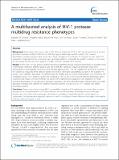| dc.contributor.author | Doherty, Kathleen M | |
| dc.contributor.author | Nakka, Priyanka | |
| dc.contributor.author | King, Bracken Matheny | |
| dc.contributor.author | Rhee, Soo-Yon | |
| dc.contributor.author | Holmes, Susan P | |
| dc.contributor.author | Shafer, Robert W | |
| dc.contributor.author | Radhakrishnan, Mala L | |
| dc.date.accessioned | 2012-04-25T16:16:52Z | |
| dc.date.available | 2012-04-25T16:16:52Z | |
| dc.date.issued | 2011-12 | |
| dc.date.submitted | 2011-08 | |
| dc.identifier.issn | 1471-2105 | |
| dc.identifier.uri | http://hdl.handle.net/1721.1/70131 | |
| dc.description.abstract | Background Great strides have been made in the effective treatment of HIV-1 with the development of second-generation protease inhibitors (PIs) that are effective against historically multi-PI-resistant HIV-1 variants. Nevertheless, mutation patterns that confer decreasing susceptibility to available PIs continue to arise within the population. Understanding the phenotypic and genotypic patterns responsible for multi-PI resistance is necessary for developing PIs that are active against clinically-relevant PI-resistant HIV-1 variants. Results In this work, we use globally optimal integer programming-based clustering techniques to elucidate multi-PI phenotypic resistance patterns using a data set of 398 HIV-1 protease sequences that have each been phenotyped for susceptibility toward the nine clinically-approved HIV-1 PIs. We validate the information content of the clusters by evaluating their ability to predict the level of decreased susceptibility to each of the available PIs using a cross validation procedure. We demonstrate the finding that as a result of phenotypic cross resistance, the considered clinical HIV-1 protease isolates are confined to ~6% or less of the clinically-relevant phenotypic space. Clustering and feature selection methods are used to find representative sequences and mutations for major resistance phenotypes to elucidate their genotypic signatures. We show that phenotypic similarity does not imply genotypic similarity, that different PI-resistance mutation patterns can give rise to HIV-1 isolates with similar phenotypic profiles. Conclusion Rather than characterizing HIV-1 susceptibility toward each PI individually, our study offers a unique perspective on the phenomenon of PI class resistance by uncovering major multidrug-resistant phenotypic patterns and their often diverse genotypic determinants, providing a methodology that can be applied to understand clinically-relevant phenotypic patterns to aid in the design of novel inhibitors that target other rapidly evolving molecular targets as well. | en_US |
| dc.description.sponsorship | Wellesley College | en_US |
| dc.description.sponsorship | National Institutes of Health (U.S.) (NIHR01GM086884) | en_US |
| dc.description.sponsorship | National Institutes of Health (U.S.) (Grant AI068581) | en_US |
| dc.description.sponsorship | National Institutes of Health (U.S.) (Grant P01GM066524-06) | en_US |
| dc.description.sponsorship | National Institutes of Health (U.S.) (Grant GM82209) | en_US |
| dc.description.sponsorship | Howard Hughes Medical Institute | en_US |
| dc.description.sponsorship | Wellesley College (Brachman-Hoffman fund) | en_US |
| dc.description.sponsorship | National Science Foundation (U.S.) (NSF-REU) | en_US |
| dc.publisher | BioMed Central Ltd. | en_US |
| dc.relation.isversionof | http://dx.doi.org/10.1186/1471-2105-12-477 | en_US |
| dc.rights | Creative Commons Attribution | en_US |
| dc.rights.uri | http://creativecommons.org/licenses/by/2.0 | en_US |
| dc.source | BioMed Central Ltd | en_US |
| dc.title | A multifaceted analysis of HIV-1 protease multidrug resistance phenotypes | en_US |
| dc.type | Article | en_US |
| dc.identifier.citation | Doherty, Kathleen M. et al. “A Multifaceted Analysis of HIV-1 Protease Multidrug Resistance Phenotypes.” BMC Bioinformatics 12.1 (2011): 477. Web. | en_US |
| dc.contributor.department | Massachusetts Institute of Technology. Department of Biological Engineering | en_US |
| dc.contributor.mitauthor | King, Bracken Matheny | |
| dc.relation.journal | BMC Bioinformatics | en_US |
| dc.eprint.version | Final published version | en_US |
| dc.type.uri | http://purl.org/eprint/type/JournalArticle | en_US |
| eprint.status | http://purl.org/eprint/status/PeerReviewed | en_US |
| dc.date.updated | 2012-03-16T16:48:51Z | |
| dc.language.rfc3066 | en | |
| dc.rights.holder | Doherty et al.; licensee BioMed Central Ltd. | |
| dspace.orderedauthors | Doherty, Kathleen M; Nakka, Priyanka; King, Bracken M; Rhee, Soo-Yon; Holmes, Susan P; Shafer, Robert W; Radhakrishnan, Mala L | en |
| dspace.mitauthor.error | true | |
| mit.license | PUBLISHER_CC | en_US |
| mit.metadata.status | Complete | |
